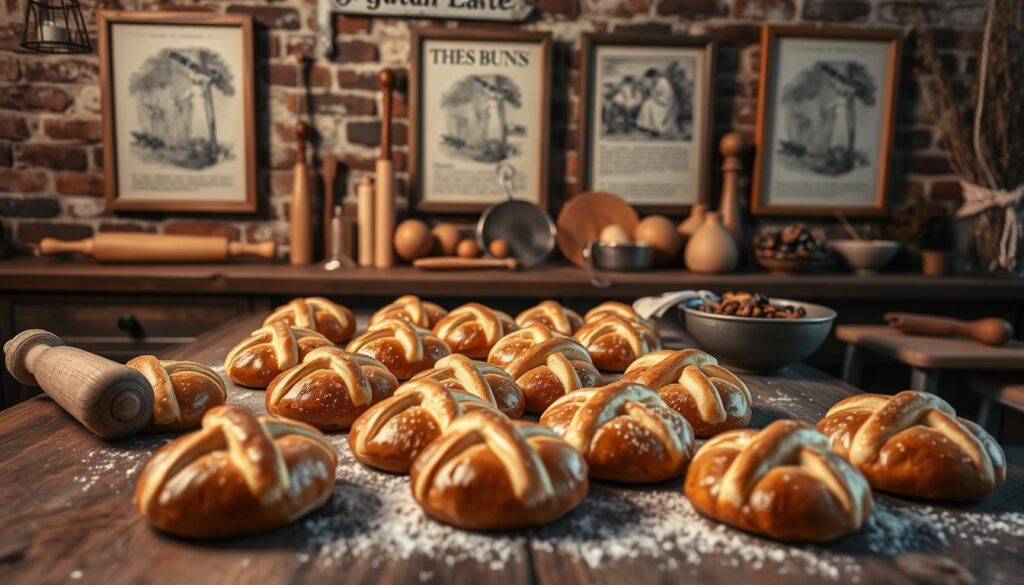Few baked goods carry as much symbolism as hot cross buns. These spiced, sweet treats are a staple during Easter, but their origins go far beyond modern celebrations. We’ll uncover how they evolved from ancient rituals to beloved seasonal favorites.
The iconic cross on top isn’t just decoration—it holds deep meaning. Some tie it to religious traditions, while others link it to folklore. No matter the interpretation, this simple marking has made the bread instantly recognizable worldwide.
From Caribbean rum-soaked versions to Australian twists with Vegemite, regional adaptations keep the tradition alive. We’ll dive into the science behind perfect dough and share time-tested recipes. Join us as we celebrate this timeless food and its cultural significance.
The Origins of the Hot Cross Bun: A Journey Through Time
What began as pagan offerings evolved into a symbol of faith and community. These spiced treats trace their origins to Saxon moon cakes, honoring Eostre, the goddess of spring. Early Christians later repurposed the cross top as a crucifixion marker, blending old and new traditions.
Pagan Roots and the Goddess Eostre
Archaeologists found evidence of round cakes baked for spring festivals. The Saxons shaped them like the moon, celebrating rebirth. Eostre’s connection to fertility made them sacred—a precursor to today’s dough.
Christian Adoption and the Symbolism of the Cross
By the 7th century, missionaries used the buns to teach Easter’s meaning. The cross became a visual sermon, turning pagan symbols into Christian ones. This clever adaptation helped spread the faith.
16th-Century England: The First Recorded Recipes
Queen Elizabeth I’s 1592 law limited sales to holidays. Bakers used rare spices like cardamom, showing wealth. Food historian Ivan Day notes London’s 1733 street cries as the first written proof of their popularity.
The Cultural Significance of Hot Cross Buns
Good Friday markets once buzzed with cries of “Two a penny!” These spiced treats weren’t just food—they marked the end of Lent’s 40-day fast. For many, they were the first leavened buns enjoyed since Ash Wednesday, making them a symbolic rebirth.
Good Friday and the End of Lent
An 1884 Hawaiian newspaper ad proves how far the tradition spread. Bakers used flour, water, and precious spices to create these celebratory treats. The cross, tied to the crucifixion of Jesus, turned them into edible sermons.
Superstitions and Healing Beliefs
Many believed buns baked on Good Friday never molded—a myth tied to Eucharistic bread. British Museum records show families hung them in kitchens as fire charms. Sailors carried them to ward off shipwrecks, blending faith with folklore.
The Nursery Rhyme and Street Cries of London
In 1767, the London Chronicle printed the original “One a penny, two a penny” lyrics. Street vendors’ chants evolved into a children’s rhyme, cementing the buns in pop culture. Today, it’s a nostalgic example of edible history.
Traditions and Folklore
Beyond their delicious taste, these spiced treats carry centuries of folklore. Some beliefs border on magic—like the idea that they never spoil. Others tie them to protection and prosperity, weaving food into daily rituals.

Buns That Never Spoil: Myths and Legends
An 18th-century claim insisted Good Friday batches stayed mold-free for a year. Modern tests debunk this—yet dried cross bun specimens in museums remain intact. The myth likely stems from their low moisture and sugar content, acting as natural preservatives.
British families once hung them in kitchens to ward off fires. Sailors carried them to prevent shipwrecks, believing the cross offered divine protection. Today, these tales remind us how food intertwines with human hope.
Protection at Sea and in the Kitchen
Nautical traditions prized these buns as talismans. Crews stored them in crow’s nests during storms, trusting the cross to calm waves. On land, bakers added extra currants or fruit as offerings to household spirits.
Regional Variations: From Jamaica to Australia
Jamaica’s version swaps sugar for molasses, often paired with sharp cheddar. The contrast of sweet and salty is a recipe for obsession. Meanwhile, Australia’s 2024 Pizza Shapes bun sparked debates—proof that innovation keeps traditions alive.
- Caribbean fusion: Mauby (a bitter herbal drink) balances the sweetness of cheese-stuffed buns.
- British vs. Australian crosses: Pastry strips vs. piped flour paste.
- Supermarkets now drive trends with limited-edition flavors like salted caramel or matcha.
These adaptations show how immigration and creativity reshape a timeless classic. Whether eaten for luck or flavor, the hot cross bun remains a cross buns easter staple worldwide.
Hot Cross Buns Today: From Tradition to Trend
Modern bakeries reinvent this spiced classic with bold flavors like salted caramel. UK supermarkets sell 11 million annually—proof of its lasting appeal. Today’s bakers experiment with chocolate-dipped versions and apple-cinnamon swirls, honoring traditions while innovating.
Instant yeast revolutionized proving methods, speeding up dough prep. Artisanal sourdough adaptations coexist with factory lines, ensuring everyone enjoys these treats. Paul Hollywood’s Bake-Off recipe even includes a citrus glaze twist.
Still eaten on Good Friday and marked with a cross, their symbolism endures. Yet, they’re far from ‘one a penny’—now a global phenomenon. Plant-based versions and AI-generated flavor combos hint at an exciting future.


